Physical Address
304 North Cardinal St.
Dorchester Center, MA 02124
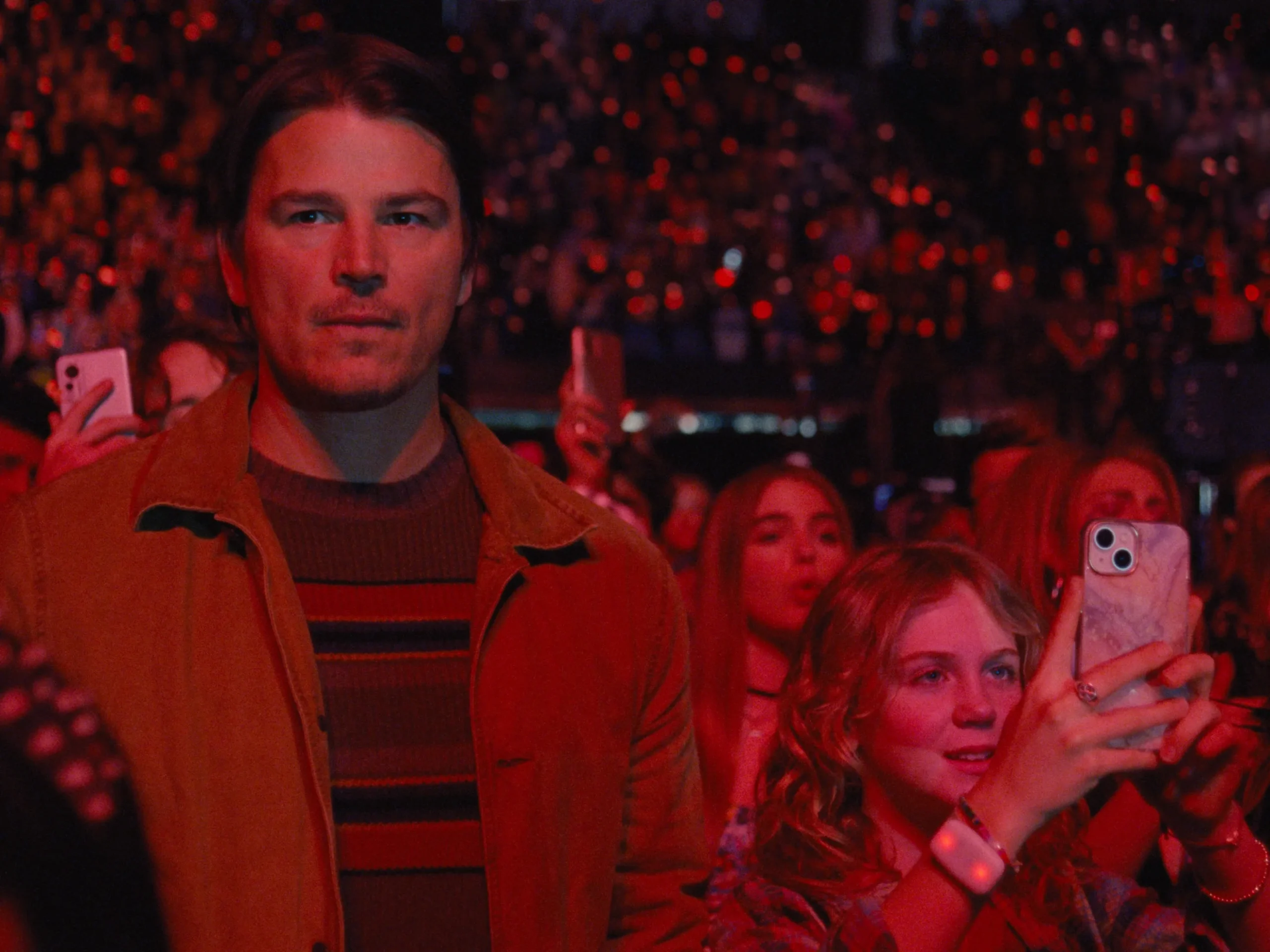
Spoiler Warning: This review includes significant plot details that may reveal crucial moments of the movie.
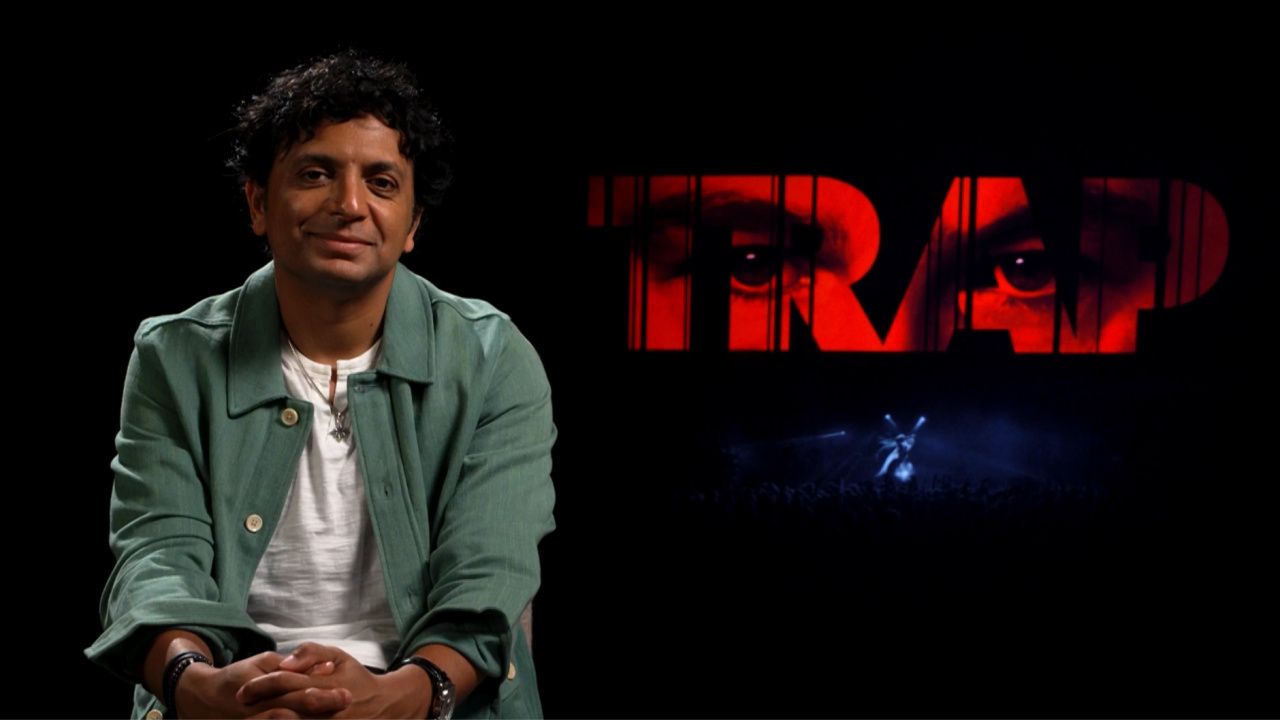
First off, I have to admit, I’m not the biggest fan of M. Night Shyamalan. I’ve enjoyed some of his films, like The Village and Lady in the Water, but my experience with his version of The Last Airbender left me pretty disappointed. Since then, I haven’t felt as drawn to his work. So, when I saw Trap as the top movie on Max, I was a little hesitant. But, with nothing particularly interesting to watch on Netflix right now, I figured I’d give it a shot.
Curious about what I was getting myself into, I looked up some information on Trap and found out that Shyamalan didn’t actually direct the movie; instead, Anthony Byrne took the reins as director. I’m not very familiar with Byrne’s work, but I did a bit of research to get a better sense of his background and the film’s production journey. Here’s what I found out.
Trap is a thriller directed by Byrne, who crafted it alongside Natalie Dormer, co-writing the script. The film aims to delve into themes of isolation, resilience, and fear, which made the production a bit challenging from the start. Byrne’s dedication to authenticity led him to choose real locations over heavy CGI effects, giving the film a more grounded, intense atmosphere. This decision required intense performances from the cast, who had to deal with physically demanding scenes. Filming relied heavily on minimalistic sets and dim lighting, capturing that claustrophobic feeling essential to a solid psychological thriller. Dormer, who was deeply involved in both the story and her character’s design, also brought extra depth to the film.
Shyamalan, on the other hand, stepped in as an executive producer, which initially had me a bit on edge. Although I may have my reservations about him as a director, I respect his knack for creating suspenseful, atmospheric films. As an executive producer, Shyamalan focused on the movie’s overall tone and pacing, helping to shape a narrative style that reflects his psychological storytelling strengths. He collaborated with Byrne to enhance specific scenes and build suspense in ways that feel natural rather than forced. His involvement helped ensure the movie maintained a consistent, gripping feel, though he stayed out of the daily production details.
As for Byrne himself, his previous work in television and film has largely focused on dramas with a dark, intense edge. He’s known for directing some well-regarded series, like Peaky Blinders, Nine Perfect Strangers, and Ripper Street. While I haven’t watched Peaky Blinders myself, I know it’s a highly respected show, and I can appreciate that. I’m hopeful that Byrne’s experience with these types of stories will bring a solid psychological thriller vibe to Trap.
So, with a bit of cautious optimism, I’m ready to dive in. Part of me is excited to see a well-crafted thriller, but I have to admit I’ll be a bit let down if there’s a typical Shyamalan twist at the end—those twists feel a bit overplayed to me at this point. Either way, I’m curious to see how Byrne’s vision and Shyamalan’s guidance come together in Trap, and I’m looking forward to the experience.
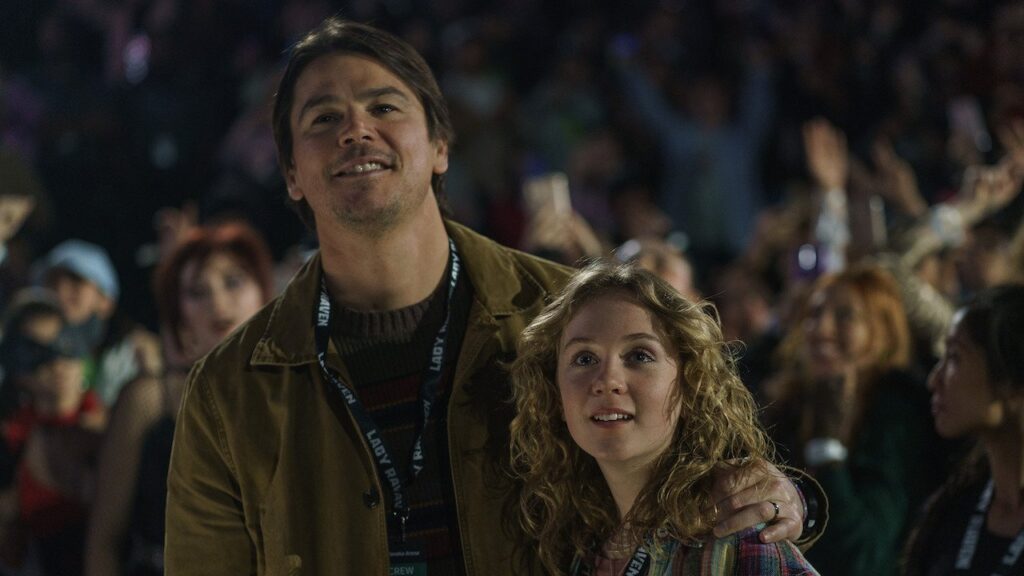
The movie opens with a simple but deeply relatable scene. Riley, a teenage girl, is singing along to a pop song on the radio, sitting in the car with her dad, Cooper, played by Josh Hartnett. I have to admit, I wasn’t a fan of Hartnett back in the 2000s—he always came across as a wannabe heartthrob, cast more for his looks than any serious acting talent. But here, in Trap, he seems to have found his niche, stepping into a fatherly role that feels natural and unforced. He brings a quiet, comforting presence to Cooper, the kind that makes him genuinely relatable in this moment as he shares this casual, sweet scene with his daughter.
When they arrive in the arena’s parking lot, Cooper and Riley spot Lady Raven’s tour bus, and a crowd of fans erupts in cheers as the pop star waves at them. Lady Raven has that almost mythical pop persona—she’s like a Taylor Swift prototype, an icon for her fans. Riley lights up at the sight of her, and you can see Cooper’s amusement, watching his daughter experience this moment.
As they enter the arena and head up the escalator, Cooper pauses and glances back toward the entrance, looking slightly uneasy. It’s as though the movie is telling us there’s something significant about this moment. The way he stops to look back, especially with police officers in riot gear stationed nearby, adds an element of mystery. Maybe Cooper finds it strange or unsettling, or maybe the movie is foreshadowing a later scene involving the police. Having never been to a pop concert, I honestly couldn’t say if riot police are typical at these events, but seeing them here definitely feels out of place.
As they grab a quick snack, we get a few more lingering shots of the police and security teams scattered throughout the arena. Cooper seems to take note of them too, which gives the scene an undercurrent of unease, as if the day’s bright tone is only a cover for something sinister. When the lights dim to signal the start of the show, the crowd erupts, and the atmosphere becomes a blur of sound and excitement.
Cooper winces, clearly unprepared for the overwhelming volume of screaming teenage fans, while Riley is in her element, shrieking and cheering with all the enthusiasm of a true superfan. Ariel Donoghue, who plays Riley, really nails this moment—her excitement is infectious and captures the energy of a young fan at her first big event. It’s easy to believe in her character’s obsession with Lady Raven, and you can almost feel the thrill of the crowd through the screen.
The concert is given a fair amount of screen time, with Lady Raven performing several pop songs on stage. I’m not sure if these are original songs created for the movie or real hits, but they feel surprisingly authentic. The music has that catchy pop quality that makes you think they could be chart-toppers in real life, adding an extra layer of realism to the scene. The creators clearly put thought into this part of the film, and it pays off in making the setting feel believable.
Eventually, Cooper leans over to tell Riley he’s going to the bathroom and reminds her to stay in her seat. At this point, there’s a noticeable shift in tone, and you can feel the tension building. It’s as if the perfect father-daughter day has reached its peak, and now, everything is primed to go wrong. The calm before the storm is unmistakable, and as Cooper steps away, you know something is about to unfold. The second act is on the horizon, and all that’s left is to buckle in and see where it takes us.
As the movie shifts gears, Cooper’s visit to the bathroom escalates into a tension-filled sequence. Once inside a stall, he immediately goes on his phone, where he views a disturbing surveillance video of a man chained in a basement. In that moment, I can’t help but think, “Is Cooper a killer?” It’s a realization that changes everything. Cooper’s role as a fatherly figure takes a dark turn, and I’m left wondering what this means for Riley, his seemingly innocent daughter, who is totally unaware of the danger surrounding her own father.
The suspense builds further when Cooper sees a mysterious older woman in the bathroom, only for her to disappear moments later. Shortly after, Riley’s ex-best friend’s mother appears, casually mentioning that the girls are no longer friends, which only adds to the eeriness of the scene. Meanwhile, outside the bathroom, police officers begin surrounding the building, joined by the FBI. It’s strange—there are hundreds of officers, all meticulously positioned, and you can feel the tension tightening.
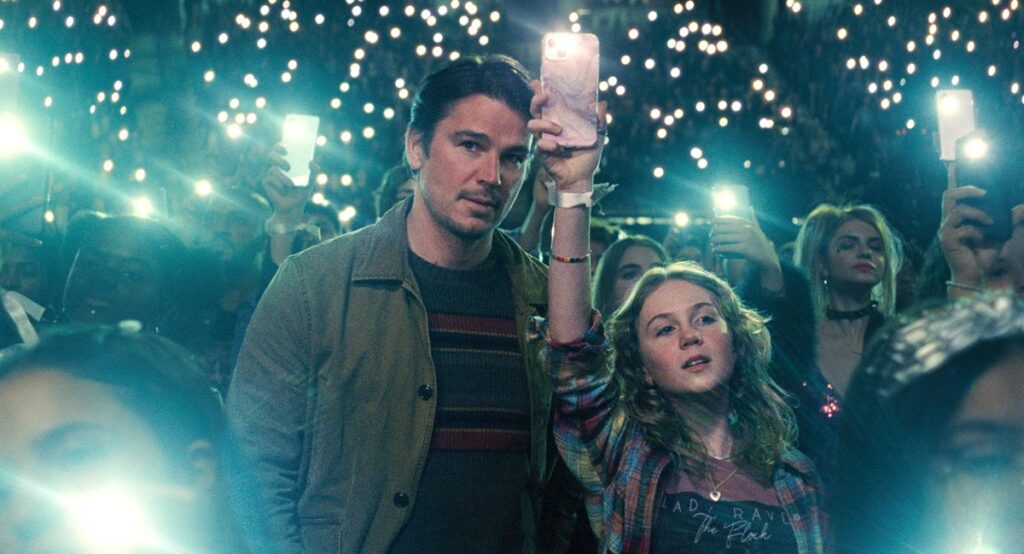
When Cooper returns to the concert, he observes something unusual: the crowd has turned on their phone flashlights, and a man is escorted out from the upper section. Then there’s an intermission. Cooper and Riley pause at a merchandise stand, where Cooper has a tense exchange with the worker, who reveals that the overwhelming police presence is there to catch a killer. And that’s when the twist hits: the police are there for Cooper. This revelation is one of those rare, spine-chilling moments. It’s a brilliant twist, reminiscent of Shyamalan’s best surprises, but here, it doesn’t wait until the end. This early revelation sets the stage for an intense cat-and-mouse game.
As a recent fan of the horror thriller Don’t Move, which featured a similar dynamic with a seemingly ordinary father turned killer, I find the setup in Trap even more compelling. For a while, we’ve rooted for Cooper, hoping for a safe, happy day for him and Riley, but now, there’s an unsettling tension. On one hand, I’ve sympathized with him, but on the other, it’s obvious he’s a danger who deserves to be caught. The complexity of this dynamic and the way it twists my feelings as a viewer is brilliant—it’s morally jarring and makes me genuinely anxious for Riley.
The situation only escalates as Cooper grows increasingly desperate. With police everywhere, his panic is palpable. In a shocking moment, he shoves a woman down a flight of stairs, showing a different, violent side of him. Riley, still oblivious to her father’s dark side, begins to sense that something is off as they return to their seats. At the concert’s intermission, a guest performer is introduced, and Cooper’s attention shifts again to the entrance. He suggests to Riley that they should check it out, likely as part of his plan to evade capture, even if it means putting his daughter in harm’s way.
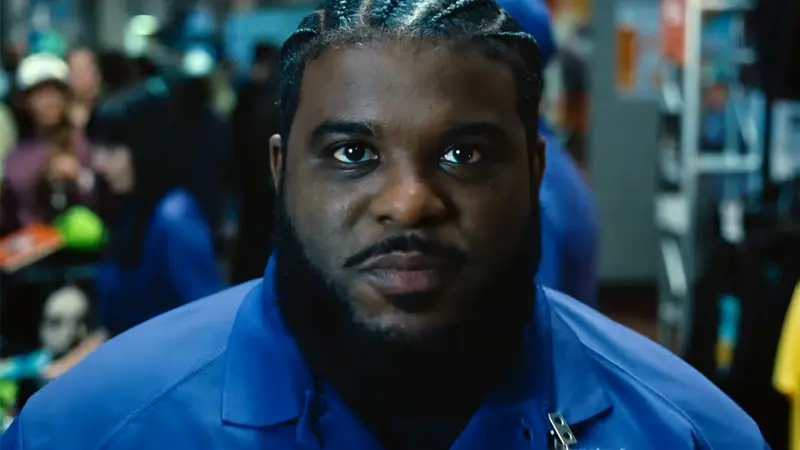
In another tense exchange, Cooper swipes a key card from an employee at a merchandise stand. The employee, trying to be helpful, even gives him a box cutter, unaware of Cooper’s true nature. By now, I’m genuinely worried for this unsuspecting worker; he’s been nothing but kind, and I hope he doesn’t become another victim. Fortunately, Cooper doesn’t harm him, but the suspense remains thick as Cooper heads into an “Employees Only” area.
There, he encounters a large group of SWAT officers and quickly moves on, grabbing a cup of coffee and stealing a police radio along the way. It’s impressive, almost Jason Bourne-level crafty, watching Cooper navigate these obstacles. The suspense keeps building, and I find myself genuinely gripped by this intense thriller.
As he returns to the main event, Cooper runs into Riley’s ex-best friend’s mom again. In the midst of all this, there’s a disturbance in a nearby hallway, and police begin making arrests. Returning to his seat, Cooper listens to the police radio, learning that he’s been identified as a suspect based on a tattoo on his arm. Thinking quickly, he covers it with a wristband, which only underscores how calculated and resourceful he is. Despite knowing the truth about him, I still feel conflicted—I’m caught between hoping he escapes and reminding myself that he’s a true menace.
Cooper then leaves Riley, telling her to meet him by a drink stand, and deliberately causes a scene by spilling hot fryer oil on a worker. The scalding oil severely injures the person, who will likely be scarred for life. This moment fully reveals Cooper’s heartlessness; he’s willing to harm anyone in his path, and there’s a cold, casual cruelty to it that’s unsettling. As he watches the injured worker suffer, Cooper experiences another eerie vision of the older woman from earlier. I can’t help but wonder if this woman is his mother, maybe someone who abused him and left him deeply scarred.
Meeting up with Riley, she confronts him, sensing that he’s acting strange. As they return to their seats, Riley talks excitedly about a tradition at the concert where a “chosen girl” gets to go backstage—a notion that gives Cooper an idea. Heading toward the stage, Cooper runs into a man, played in a cameo by Shyamalan himself, which adds a bit of levity to the scene. Cooper tells the man that Riley recovered from leukemia, an emotional ploy to secure their spot closer to the stage.
The police are closing in, but Cooper’s gamble pays off. The man announces that Riley has been chosen as the “dreamer girl,” granting her the opportunity to go backstage. She’s overjoyed as she and her father are given special lanyards and escorted to the back. As Riley gets instructions to go onstage at a certain point, Cooper spots Dr. Josephine Grant, the profiler leading the search, who has arrived near the stage area. Riley goes out to dance with Lady Raven, delivering a surprisingly impressive performance. Meanwhile, Cooper barely manages to hide from Dr. Grant, who seems to be getting closer.
The way this movie hijacks my brain is remarkable. Between the intense cinematography, suspenseful music, and clever framing, I’m almost instinctively rooting for Cooper to evade capture, even though I know he’s a killer. Dr. Grant, the profiler who should represent justice, is somehow cast as a figure to avoid, as though she’s the one disrupting Cooper’s day. I don’t know if the filmmakers did this intentionally, but if they did, they deserve credit for toying with my perception like this. The tension is relentless, and the morally complex characters make Trap an unforgettable ride.
As the tension heightens, Riley and Cooper find themselves backstage, where they have the unique experience of watching Lady Raven up close. Cooper takes note of her dependence on an inhaler for asthma, a seemingly small detail that will likely play into his plans. When Cooper asks a staff member if there’s a way to exit the arena from backstage, she confirms that they can, which brings a sense of relief—as though Cooper and Riley might actually escape. But there’s still over fifty minutes left in the movie, so the uncertainty of what’s to come keeps me on edge.
As they move down a backstage hallway, Cooper puts his earpiece back in and hears Dr. Grant instructing officers to check every male in attendance. Their exit route involves a security checkpoint, making it clear that Cooper’s situation is far from simple. Meanwhile, the backstage manager shows where they can exit, but a security check looms as an unavoidable obstacle. Lady Raven then approaches Dr. Grant for an update, suggesting that her cooperation is integral to the operation. She meets Riley, who is starstruck, and this connection with Riley gives Cooper an opportunity to manipulate Lady Raven.
Surprisingly, Cooper manages to convince Lady Raven to talk to him alone. The two slip into her dressing room, and he reveals his identity to her—a bold and risky move. Pausing the movie at this point, I’m taken aback; I did not expect him to reveal himself so openly. Clearly, he’s desperate, and I’m anxious to see how he’ll use this information. The stakes are raised when Cooper shows Lady Raven a live video feed of his hostage, threatening to kill them if she doesn’t help him and Riley escape in her limousine.
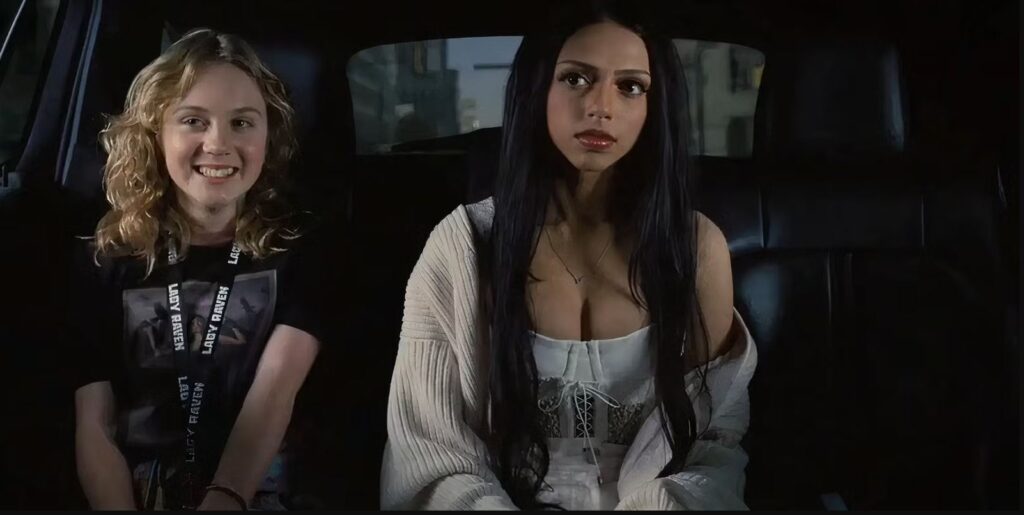
Lady Raven, visibly unsettled, leads Cooper and Riley toward the limo. The scene cuts to Dr. Grant, her face slowly coming into focus, a clear signal that the police aren’t letting Cooper slip away that easily. As the limousine pulls out of the arena, a new layer of tension emerges. Lady Raven sits in silence, visibly disturbed by being coerced into aiding Cooper’s escape. But there’s a flicker of defiance in her eyes when she suggests to Riley that they could drop her off at home—a plan that Riley finds thrilling. Lady Raven’s glances toward Cooper seem to say, “You’re not getting away with this.”
The limo pulls up to Cooper’s house, where Riley excitedly introduces Lady Raven to her mother. Unexpectedly, Riley’s mom invites Lady Raven inside for a meal, and she accepts, marking a twist I didn’t see coming. Lady Raven, now in the “monster’s lair,” exudes a strange calmness. It’s almost as if she’s investigating Cooper on her own terms, confident that she’s in control. But Cooper isn’t about to let her take charge; he leans close and whispers a threat, warning her that he’ll kill his hostage if she makes a move.
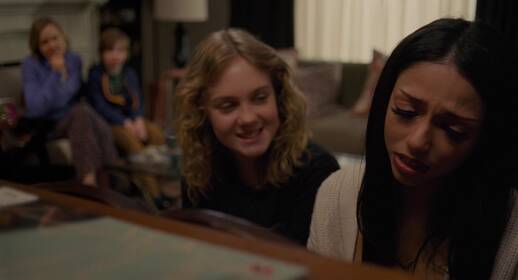
Lady Raven engages with Cooper’s family, including a tense conversation with his wife, where she subtly drops hints about “The Butcher”—the name of the killer. It’s a daring move, suggesting that she might know more about Cooper than she’s letting on. Cooper tries to usher her out, but Lady Raven, holding her composure, heads to the piano and begins to play a song, inviting Riley to join her. There’s a moment where Lady Raven hands Riley something, perhaps her phone, although it’s not entirely clear.
The tension is thick as Lady Raven starts singing, distracting the family while she deftly swipes Cooper’s phone. She heads to the bathroom, and when Cooper realizes his phone is missing, he panics, his behavior startling Riley. Cooper’s growing agitation only intensifies as he pounds on the bathroom door, but inside, Lady Raven is already a step ahead. Using Cooper’s phone, she contacts the hostage, trying to extract information that could help the FBI locate them. The hostage mentions seeing a lion’s head, perhaps a clue that could lead to his whereabouts.
At this point, I paused the movie to gather my thoughts, realizing that my perspective has completely shifted. Somewhere along the way, I stopped rooting for Cooper and began to cheer for Lady Raven. Cooper, who once seemed like a protagonist caught in a high-stakes scenario, now feels like a villain, and I’m genuinely concerned for Lady Raven’s safety and her success in exposing him.
Curious as to when this change happened, I rewound the movie to the moment Lady Raven first entered Cooper’s home. That subtle shot, showing her back as she walked into his space, has an eerie quality—almost as if we, the audience, are sneaking up behind her, sharing her vulnerability without her knowing it. The cinematography feels intentional, pulling us into her perspective and creating a sense of suspense as we view Cooper through her eyes.
By the time Lady Raven is locked in the bathroom, trying to uncover the hostage’s location, I’m entirely on her side. The movie has managed to rewire my brain, turning Cooper from a sympathetic father figure into an undeniable threat. There’s no question now that he’s a dangerous, calculating predator, and Lady Raven’s courage in navigating this terrifying situation is what I find myself invested in. Trap expertly plays with perspective, challenging viewers to confront the disturbing realization that our early sympathies for Cooper were misplaced. Now, the only hope is that Lady Raven can escape his clutches and ensure justice is served.
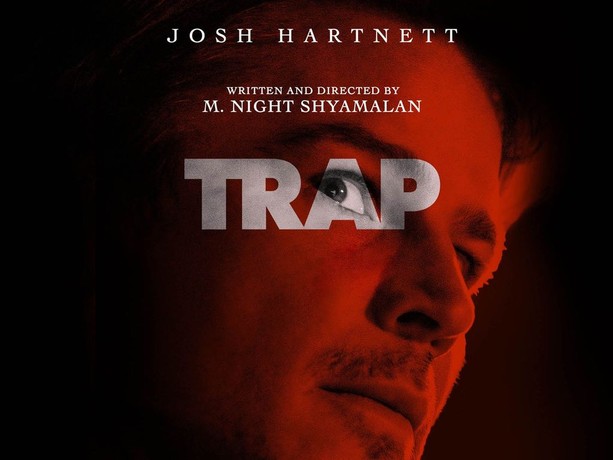
The tension reaches a fever pitch as Lady Raven takes a bold step: she starts a live stream, dropping hints to the public about the hostage’s location, referencing the lion’s head and a blue door. The intensity of the music rises as Cooper’s aggression mounts, and viewers see someone claim they know where this location is.
Lady Raven urges them to go there immediately, even texting the limo driver to contact the police. At the bathroom door, she seems to be waiting for confirmation that the hostage has been safely rescued. Just as she shouts to Rachel, Cooper’s wife, revealing that he is, in fact, the Butcher, the silence is broken by Cooper’s calm yet chilling demand for the phone. A terrifying moment follows when Cooper realizes the hostage, Spencer, has indeed been saved.
Cooper forces Lady Raven into Rachel’s car, seemingly bent on escaping, while Lady Raven cleverly tries to break through to him, pretending to be his mother in a desperate bid to connect with him emotionally. He finally opens the garage door, revealing his family standing there. In a surprising moment, Cooper lets Lady Raven go, closing the garage door and sealing himself inside.
The police arrive on the scene, swarming the house, and as they close in, Cooper escapes through a hidden tunnel. However, he soon reappears, now having kidnapped Lady Raven in the limo. In a quick-thinking move, Lady Raven rolls down the window, attracting the crowd’s attention just before managing to escape, while the police disable the limo by shooting out its tires. Still, Cooper vanishes without a trace.
As the scene shifts, Lady Raven visits Spencer, the rescued hostage, who is visibly shaken but safe. Meanwhile, Dr. Grant meets with Rachel, explaining the profile she’s built on Cooper. At home, Rachel is startled by Cooper’s sudden appearance, and it’s clear he’s growing increasingly suspicious that she may have been the one who alerted the police. In a quiet but charged scene, Rachel confesses to tipping off the FBI, and in an unexpected twist, she suggests they share a final slice of Riley’s pie together.
The pie scene is puzzling. You’d think Rachel, dealing with the trauma of her husband’s dark revelations, wouldn’t have any appetite for such a “normal” moment. But somehow, it fits with the odd, tense rhythm of the movie’s ending. As they eat, Cooper opens up about the rage he feels, directing his anger and sense of betrayal toward Rachel, lamenting that he won’t get to watch his kids grow up.
Then, in a move I didn’t see coming, Rachel drugs Cooper, showing a brilliance and resourcefulness I wasn’t expecting. At this moment, the movie’s title, Trap, seems almost poetic—first, Cooper traps his victims, then Lady Raven becomes trapped in his plans, and now, Rachel turns the tables by trapping Cooper himself. It’s a clever play on the film’s theme.
Cooper starts to hallucinate, seeing his mother, and stumbles toward this vision just as the police arrive and tase him, bringing him under control. He’s finally arrested, but even in this moment, the film doesn’t let up. We see a strange compulsion come over Cooper, almost an OCD-like need to adjust a bike nearby, a small but unnerving detail. Riley comes to him, and they share a quick, emotional embrace before he’s led away by the police.
In the final scene, Cooper reveals one last trick up his sleeve. Smiling, he deftly removes something from the bike, using it to free himself from the cuffs and letting out a chilling laugh as the screen cuts to black. The abrupt cliffhanger ending left me conflicted. On one hand, I appreciate the movie’s dedication to keeping the tension high until the very end. On the other, this ending felt like a shortcut, an unresolved note that doesn’t fully satisfy.
I started thinking about an alternate ending that would shift the focus more meaningfully. Imagine Riley and her brother as adults, now trained under Dr. Grant’s guidance, using their knowledge and experience to catch other killers. They’d still visit Cooper in prison occasionally, keeping the audience engaged with his charming yet sinister side, but there wouldn’t be this lingering, incomplete feeling the cliffhanger leaves.
Ultimately, though, Trap is a solid thriller that succeeds at keeping you on edge, twisting your loyalties, and immersing you in its psychological complexities. Whether it stands out in my mind for years to come remains to be seen—it’s too soon to decide. But while the ending may not be perfect, the journey there is intense and unique. If you’re in the mood for a suspenseful ride with unexpected turns, Trap delivers. I definitely recommend it, even with its imperfect finale.
Click here for my latest posts!